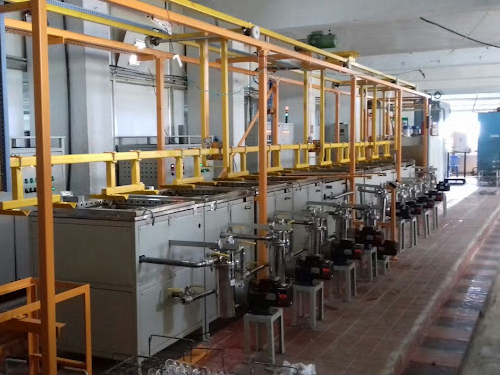
Glass Machinery
Introduction: Glass is a versatile material used in a wide range of industries, including architecture, automotive, electronics, and home decor. To meet the increasing demand for high-quality glass products, manufacturers rely on advanced glass machinery. These cutting-edge machines and equipment enable precise shaping, cutting, polishing, and processing of glass, ensuring exceptional craftsmanship and efficiency. In this article, we will explore the working principles, key features, applications, and benefits of glass machinery.
Working Principles: Glass machinery encompasses various types of equipment, each designed for specific glass processing tasks. Here are some common working principles employed in glass machinery:
- 1.Cutting: Glass cutting machines use different methods, such as diamond or carbide-tipped blades, waterjet technology, or laser beams, to cut glass with precision. The machines can be programmed to follow specific designs or shapes, allowing for intricate cuts and patterns.
- 2.Shaping: Glass shaping machines utilize grinding and polishing mechanisms to shape glass into desired forms. These machines employ rotating discs, belts, or wheels coated with abrasive materials to remove excess glass and achieve the desired shape and smoothness.
- 3.Tempering: Tempering machines subject glass to intense heat followed by rapid cooling, creating a state of high surface and internal stress. This process strengthens the glass, making it more resistant to thermal stress and mechanical impact. Tempered glass is widely used in automotive windows, shower enclosures, and architectural applications.
- 4.Laminating: Laminating machines bond multiple layers of glass together using an interlayer, typically made of polyvinyl butyral (PVB). The machine applies heat and pressure, ensuring a strong adhesion between the glass layers. Laminated glass provides enhanced safety and security by retaining glass fragments upon breakage.
- 5.Insulating: Insulating glass machinery is used to produce double or triple glazing units. The machine assembles multiple glass panes with a spacer and seals the edges, creating an insulating air or gas-filled space. Insulating glass improves thermal insulation, noise reduction, and condensation control in windows and doors.
Key Features:
- 1.Precision Control: Glass machinery incorporates advanced control systems to ensure precise operation and high-quality output. These systems allow for accurate positioning, speed control, and pressure regulation during cutting, shaping, and processing. Precise control guarantees consistent results and minimizes material waste.
- 2.Automated Operation: Many glass machines are equipped with automation features, reducing the need for manual intervention and improving productivity. Automated loading and unloading systems, robotic arms, and computer numerical control (CNC) capabilities enable efficient handling and processing of glass, optimizing workflow and reducing labor costs.
- 3.Customization Options: Glass machinery often offers customization options to accommodate various glass sizes, thicknesses, and shapes. Adjustable settings for cutting parameters, grinding pressures, and polishing speeds allow manufacturers to adapt the machines to different glass processing requirements, ensuring versatility and flexibility.
- 4.Safety Features: Glass machinery prioritizes operator safety by incorporating safety mechanisms such as emergency stop buttons, safety interlocks, and protective enclosures. These features minimize the risk of accidents and injuries during operation, making glass processing safer for operators.
- 5.Integration and Connectivity: Modern glass machinery can be integrated into production lines and connected to computer networks. Integration facilitates seamless data exchange, production monitoring, and remote diagnostics, enhancing overall production efficiency and control.
Applications: Glass machinery finds applications in various industries, including:
- 1.Architectural Glass: Glass machinery is widely used in the production of architectural glass products, such as windows, doors, facades, and partitions. These machines ensure precise cutting, shaping, and edging of glass panels, meeting the design specifications and quality standards of architectural projects.
- 2.Automotive Glass: Glass machinery plays a crucial role in the automotive industry by manufacturing windshields, side windows, and rear windows. Advanced cutting and shaping machines produce glass components with high precision, adhering to automotive safety standards.
- 3.Electronics and Displays: Glass machinery is used in the production of glass components for electronic devices, including touchscreens, LCDs, OLEDs, and solar panels. The machinery ensures precise cutting, shaping, and edge polishing of glass substrates, contributing to the quality and functionality of electronic products.
- Furniture and Decorative Glass: Glass machinery is employed in the fabrication of glass furniture, such as tabletops, shelves, and cabinets. It is also used for creating decorative glass elements like mirrors, glass artworks, and stained glass panels. The machines allow for intricate cuts, beveling, and engraving, adding aesthetic value to glass products.
- 5.Packaging and Bottling: Glass machinery is utilized in the production of glass bottles, jars, and containers for the food and beverage industry. The machines ensure accurate cutting, shaping, and forming of glass packaging, maintaining uniformity and structural integrity.
Benefits:
- 1.Precision and Quality: Glass machinery enables precise cutting, shaping, and processing of glass, ensuring high-quality products with tight tolerances. Consistent and accurate manufacturing leads to superior aesthetics, functional reliability, and customer satisfaction.
- 2.Efficiency and Productivity: Automated operation, customization options, and integration capabilities enhance productivity and efficiency in glass manufacturing. Machinery reduces manual labor, speeds up production cycles, and minimizes material wastage, resulting in optimized workflows and cost-effective production.
- 3.Safety and Operator Comfort: Glass machinery incorporates safety features to protect operators and minimize workplace hazards. Safety interlocks, protective enclosures, and advanced control systems create a safer working environment, reducing the risk of accidents and injuries.
- 4.Versatility and Flexibility: Glass machinery offers versatility and flexibility by accommodating a wide range of glass sizes, shapes, and thicknesses. Customizable settings and modular designs allow manufacturers to adapt the machines to different production requirements, expanding the range of glass products that can be manufactured.
- 5.Improved Profitability: By streamlining production processes, minimizing errors, and maximizing efficiency, glass machinery contributes to increased profitability for manufacturers. Reduced material waste, enhanced productivity, and superior product quality lead to higher customer satisfaction and market competitiveness.
